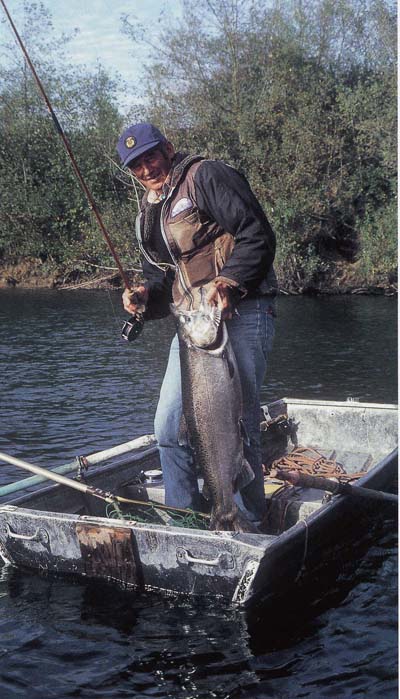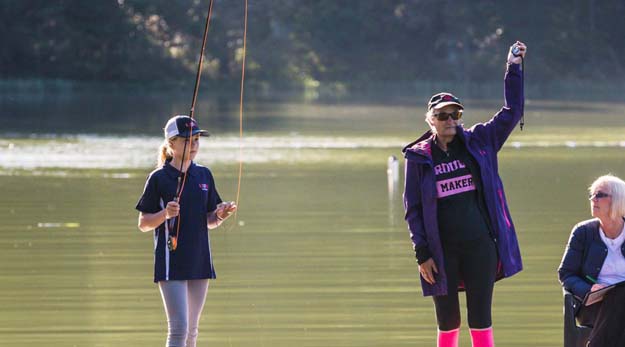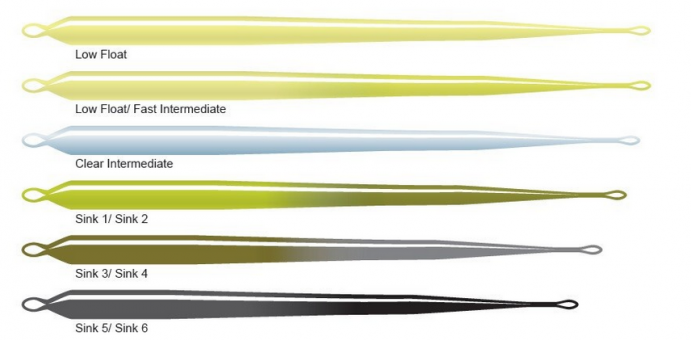Shooting heads were invented in the American West – Part I
By Dan Blanton
For some unknown reason, industry scribes, fly line and rod manufacturers have decided to make “shooting heads/tapers” a shell game in which only the “in” players can understand grams, grains and the rather outdated AFFTA charts, and more importantly, the purpose of it all in a cast.
Shooting Heads are a simple construction – a heavy tapered section of fly line is attached to a thin running line. That combination is cast in the normal manner and the heavier “shooting head” will easily pull the lighter running line at wicked speeds and enable much, much longer casts with far less effort.
[dropcap]T[/dropcap]he Sunset Line and Twine Company of Petaluma, California marketed the first commercially produced shooting head in August 1950 and “Shooting Head” is the company’s registered trademark. This is why you’ll always see them referred to as “Shooting Tapers” on packaging and in the catalogs of other line manufacturers. The concept of shooting heads goes back much further than 1950, though, having its origins in tournament casting.
Marvin Hedge of Portland, Oregon, was the first caster to use a shooting taper in competition when he unveiled a homemade 50-footer fashioned from various diameters of braided silk and size I, silk shooting line. That was back in the early 1930’s when Mr. Hedge set the casting world on fire with his unbelievably long throws, establishing a distance record of 147-feet in 1934, a record subsequently bested by G. L. McLeod in 1936 with a toss of 149-feet, that later eclipsed with a stunning cast of 183-feet in 1937 by Dick Miller. McLeod and Miller were both using a shooting taper similar in design to Hedge’s.
In those days Hedge’s 50-foot braided silk head was joined to the braided, size I silk shooting line with a short section of line slightly larger in diameter than the shooting line, called a “holding” line. The holding line’s function was similar to the monofilament casting trace used by surf casters: it performed as a shock/abrasion absorber, without which, the shooting line would soon part from the stresses of repeatedly hauling the line in and out of the rod tip during casting. This was the basic shooting taper configuration until 1946 when by accident, a new dimension was added.
Jim Green, famous rod designer and Phil Miravalle, acclaimed tournament caster, of San Francisco’s Golden Gate Casting Club were practicing for the national championships with the typical shooting heads of the time, when Jim, who has always been an innovator, decided to tie some 8-pound monofilament from his newly acquired spinning reel to the holding line of the head. During the course of the session, the holding line broke and Jim decided to tie the monofilament directly to the shooting taper. As Jim explained it, “The line took off like a bullet, adding at least 15-feet to our distance.”

Legendary Bill Schaadt with a large salmon. Photo credit Dan Blanton.
Until the championships at Indianapolis, shooting tapers with monofilament shooting line were a closely guarded secret. Jim Green swept the field with top honors and the rest of the team also cleaned up. From that moment, the shooting-taper/mono combination became the accepted tackle for tournament casting – but, others had different plans.
Charles Barfield, a fellow member of the Golden Gate Casting Club at the time, is credited with being the first fly rodder to use mono shooting line behind a head in actual fishing. Jim Green had built Charlie a typical shooting head around the time of the championships in 1946, and while Jim went to Indianapolis, Charlie went steelhead fishing – probably on the Russian River, although I could never actually document it. His enthusiasm about this new shooting head combo for West Coast steelheading prodded others to try it, and mono shooting line became standard equipment for fall salmon and winter steelheading throughout the Pacific Northwest, where long casts are the rule rather than the exception.
While the first shooting tapers of braided silk were homemade by tournament casters, self-made shooting heads, fashioned from other, non-traditional materials, such a lead-core trolling line, found their way into the fly fishing scene more than 50 years ago. And while I can’t say for sure who was the first angler to make and use a lead-core shooting head, it is generally accepted that Myron Gregory, a West Coast fly fishing legend, was the first angler to use a lead-core shooting head in saltwater to take Pacific salmon and rockfish; and, If I were to guess, I’d say he was probably the first to make and cast a lead-core head.
He later showed the Late Bill Schaadt, who became “The Legend” among western salmon and steelhead fly rodders, a lead-core head and how effective it was at taking deep-dwelling rockfish. Bill realized this line was the answer to taking King salmon from deep pools on California’s Smith River and it quickly became a most used and valued tool.
espite the standard lead-core line’s ability to dredge bottom during normal flows, it couldn’t get the job done when the rivers were nearly at flood stage, so Bill developed a new idea. Taking a length of heavy Dacron fishing line, he inserted lead fuse wire to make a lead-core shooting head of considerable density. The result became known as “The Cable.” It can be made from 2-, 3-, or 4-ampere fuse wire, weighing anywhere from 550 to 1200 grains, capable of sinking a fly so deep it’ll catch fish with headlights. Of course these lines cast just like their name implied, and needless to say, you didn’t aerialize the false cast. Water-hauling (some times referred to as water-loading) was the only safe approach to casting the cable [note: they cast much better on today’s modern rods].

Casting competition and casting clubs are still very much a part of the Western U. S. fly fishing culture. Maxine McCormick was the No. 1 female fly caster for accuracy at the U.S. Casting Championships when she was only 12, she outscored legendary world champion Steve Rajeff, who is considered by many to be the greatest competition caster in history.
A system can always be improved, and Frank Bertaina of Santa Rosa, California, added a new twist to Bill’s Cable. Frank removed 22-feet of the 1-ampere fuse wire from a 30-foot length of standard lead trolling line and replaced it with 2-, 3-, or 4-ampere fuse wire, creating a tapered lead core shooting head. These cables were used for years to overcome extreme conditions, until modern, nearly as fast sinking but more easily castable versions were manufactured by leading fly line companies. Extreme water conditions were the prime factor that required pulling a Cable from your line wallet, because they were, indeed, “extreme” lines. I still have a few of those that I made more than 25 years ago and have occasionally used them when the flood gates burst or when plying the bowels of bluewater. And, again, it’s interesting to note, that the Cable handles much better when cast by modern, carbon fiber rods.
Lead-core heads made of a standard trolling line are still used frequently today, by salmon, steelhead, and marine fly fishermen, despite the fact modern, vinyl-coated, extruded heads that sink nearly as fast (faster in some cases), are now available. Level tungsten lines such asRio’s T-8, T-11 and T-14 and T-17 are now extremely popular as shooting tapers. I personally, never leave home without a couple of lead-core or tungsten shooting tapers. And, there are now special, integrated T-lines, with a level intermediate shooting line that cast like shooting heads, fish deep and well, without the traditional connecting loop. Both SA and Rio produce these lines.
While it is little known, there was a movement back in the early 70’s to cast dispersion and stigma upon the use of metal-core fly lines. A few traditionalists, most from northwest steelhead regions, who felt using a line of this type wasn’t fly fishing, or that any sinking fly line resulted in too many steelhead being killed, tried to get the Federation of Fly Fishermen (as it was called at the time) to endorse regulations banning the use of all metal-core fly lines in “fly fishing only waters”. While they were quick to state in their cover letter to the F.F.F. that the rules wouldn’t effect marine fly anglers (I was one of those they were referring to), I and several others (I was an F.F.F. director at the time), felt the Federation shouldn’t endorse these types of regulations, which would ultimately stigmatize all sinking fly lines, not just metal-core versions, and possibly severely hinder the development of equally fast sinking fly lines without metal cores, by leading manufacturers. The late Jim Eriser, then President of the F.F.F., and Paul Collier, his VP agreed with me when I called them with my view that Federation shouldn’t touch this one. The move was stopped cold! Thank God! Today we have a marvelous selection of sinking lines that allow us to effectively fish the entire water column. Oh, the regulations to ban the use of metal-core fly lines in fly-only waters were imposed on many Northwest steelhead waters, but without the endorsement of the F.F.F. Today, on some of those same watercourses, you are also banned from using “indicators” when fishing for steelhead – another classic case of someone regulating someone else only to do things their way…



